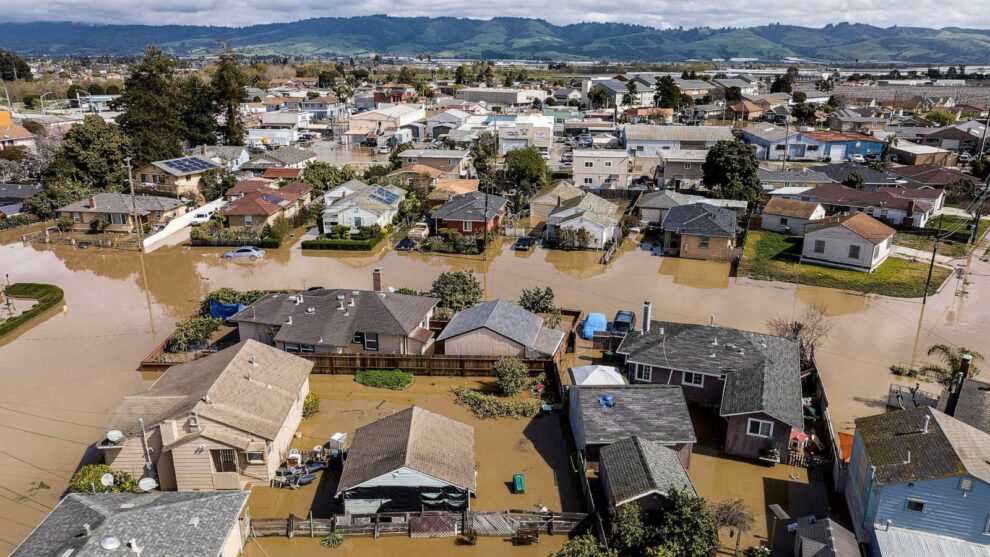Local officials say their aid isn’t conditioned on immigration status.
When California’s Pajaro River flooded around midnight on March 11, breaching a levee, the neighboring area was urged to evacuate — with many leaving around 1 a.m. carrying only the clothes on their backs, according to some of those forced to flee.
It was “the worst case scenario,” Luis Alejo, chair of the Monterey County Board of Supervisors, wrote in a tweet.
Nonprofits and the state government have stepped in to assist residents, but advocates say they have growing concerns that Pajaro is being overlooked and that many of the local immigrant families may be left behind because some of them don’t have legal status in the country — though California government officials insist otherwise, saying that their aid isn’t tied to immigration laws.
Pajaro is an unincorporated community that sits about 90 miles south of San Francisco. It is 92% Hispanic and slightly more than 18% of the 3,000 residents live under the poverty line, according to one estimate.
“I see my grandfather in a lot of these older workers. It hurts me when people fail to recognize their hard work, their humility,” said Ray Cancino, CEO of Community Bridges, a nonprofit that is helping the flood victims.
More than 330 residents are still receiving emergency shelter services as of this week, according to a statement from Monterey County Second District Supervisor Glenn Church, and more than 521 households have been served at the local assistance center.
“The County of Monterey will provide whatever assistance we can to individuals in Monterey County impacted by these terrible winter storms regardless of immigration status. In addition to any County resources, we are working with several non-profit groups that are supporting relief efforts for those with or without documentation,” a spokesman for Monterey County’s government, Nicholas Pasculli, said in a statement to ABC News. He also pointed to the state’s services for disaster victims, regardless of immigration status.
But Cancino, with the nonprofit, said the situation still raised concerns. He said that many migrants in Pajaro don’t have legal status, though situations vary and some are in the U.S. lawfully, and that complicates how much the Federal Emergency Management Agency can help them.
“There isn’t enough philanthropic opportunity for us to take care of them,” he told ABC News.
Community leader Sergio Villaron said that he is especially worried about his neighbors who are field and farm workers. With the fields flooded, Villaron said that many of them are not going to be able to work.
“That’s how they feed their families, and if they don’t have that, it’s gonna be hard times for them,” Villaron said.
A FEMA flyer said that non-monetary aid such as medical care or shelter is available to all who face disasters, no matter their immigration status, Villaron said, but he does not know if he and everyone else in his community can apply or where to start the process. (FEMA did not respond to a request for comment for this story.)
California Gov. Gavin Newsom has requested a major disaster declaration as a result of the floods. In a press release, he said that the state would support “undocumented workers and communities ineligible for FEMA individual assistance due to immigration status.”
A spokesperson for Newsom said that the state has provided $15 million through local levee assistance and other support to fund the Pajaro River Flood Risk Management Project, which would cover up to 100% of the non-federal costs for the management of the levees.
Cancino believes the majority of evacuated people in Pajaro will likely not be eligible for certain aid from FEMA because of their immigration status, and those that may qualify are the children of laborers.
He said support is crucial while Community Bridges and other nonprofits work to provide housing to the victims.
“Their landlord is going to take probably 18 to 24 months to get their funding from FEMA, to get people to fix things to get it out of habitable and during that time, there’s not gonna be any affordability available anywhere in this county,” Cancino said.
Nonprofits in the area have raised $1.2 million in cash for flood victims and more in supplies, he said, but it is “absolutely not” enough to cover all of the damages.
Newsom said in a news conference last month that $42 million was available for United Way, the international nonprofit network. But the United Way of Monterey County Director Katy Castagna said in a statement to ABC News that the correct amount for local assistance is around $300,000 and the money was from a COVID-19 relief fund, not for the flooding.
“Regarding the overall financial situation, we know it is dire for the whole community of Pajaro,” Castagna said. “A number of community-based organizations and philanthropic partners are collaborating to provide basic needs for those in the shelters, staying in cars and motels. Damage assessments have not been done and we anticipate recovery will take years.”
Amid the struggle to rebuild, Villaron said that the community thinks a lot like him: Stay positive and keep moving forward.
“I can’t feel sad about it now,” he said.
Source: ABC News















